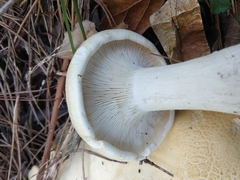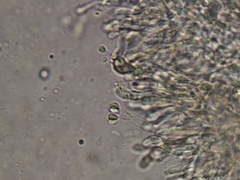Leucopaxillus: taxon details and analytics
- Domain
- Kingdom
- Fungi
- Phylum
- Basidiomycota
- Class
- Agaricomycetes
- Order
- Agaricales
- Family
- Tricholomataceae
- Genus
- Leucopaxillus
- Species
- Scientific Name
- Leucopaxillus
Summary description from Wikipedia:
Leucopaxillus
Leucopaxillus is a genus of fairly large white-spored gilled mushrooms which are found worldwide growing on the ground in woodlands. These are saprotrophs, but may sometimes be ectomycorrhizal. Less than ten species of Leucopaxillus are known to grow in North America. No species of Leucopaxillus are known to be poisonous, but they do not have an appealing taste or texture. The widespread genus contains about 15 species.
Members of Leucopaxillus are medium-sized to large, have a dry convex to depressed cap, an inrolled margin when young, lack a partial veil and have tough flesh. They have white or yellowish gills which can come off in a layer, leaving the underside of the cap smooth. The spores are white, amyloid and spiny. These mushrooms often smell bad and can be mistaken for Tricholoma and Clitocybe, but mushrooms in those genera are more fragile and rot more quickly. Members of Leucopaxillus have antibiotics which make the mushrooms persist much longer than most, making them appear to be more common than they actually are.
...Leucopaxillus in languages:
- Czech
- běločechratka
- Dutch
- Dikhoed
- Finnish
- valmukat
- Lithuanian
- Meškabudė
Images from inaturalist.org observations:
We recommend you sign up for this excellent, free service.
Parent Taxon
Sibling Taxa
Child Taxa
- Leucopaxillus albissimus
- Leucopaxillus alboalutaceus
- Leucopaxillus amarus
- Leucopaxillus barbarus
- Leucopaxillus brasiliensis
- Leucopaxillus cerealis
- Leucopaxillus compactus
- Leucopaxillus cutefractus
- Leucopaxillus eucalyptorum
- Leucopaxillus gentianeus
- Leucopaxillus gracillimus
- Leucopaxillus laterarius
- Leucopaxillus lentus
- Leucopaxillus lepistoides
- Leucopaxillus lilacinus
- Leucopaxillus monticola
- Leucopaxillus nauseosodulcis
- Leucopaxillus paradoxus
- Leucopaxillus phaeopus
- Leucopaxillus rhodoleucus
- Leucopaxillus tricolor
- Leucopaxillus vulpeculus































































































































































